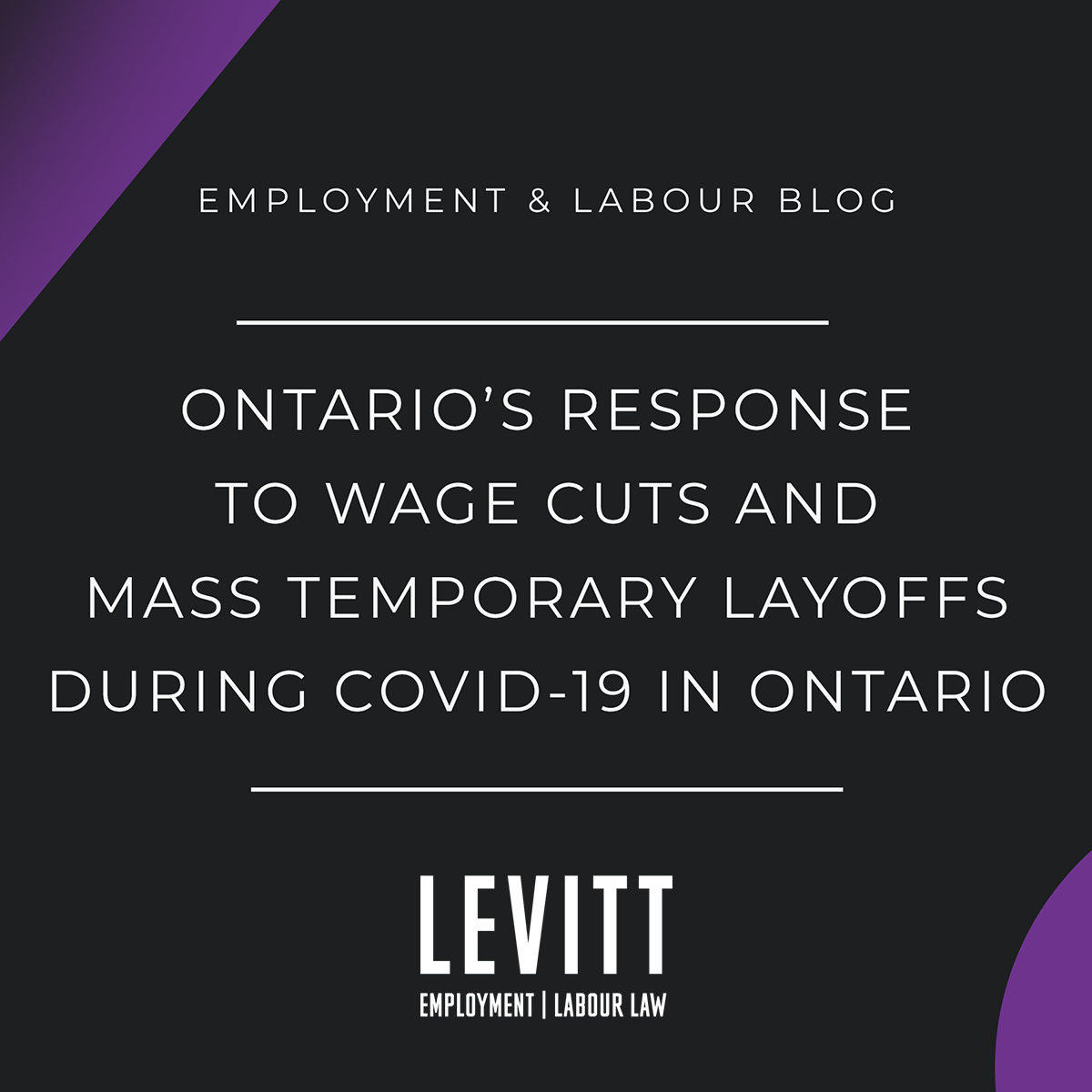COVID-19 UPDATE, June 2, 2020
Employers can breathe a sigh of relief (for now), but employees can still sue in court: Ontario’s response to wage cuts and mass temporary layoffs
Ontario has just introduced a new regulation (the “Regulation”) in response to unprecedented “temporary layoffs” and wage cuts due to COVID-19.
From the government’s perspective, the Regulation was necessary to limit imminent mass terminations and resulting termination payments to employees. It provides a temporary sigh of relief for employers during the “COVID-19 period”, which is from March 1, 2020 until six weeks following the end of the State of Emergency.
The following are the key changes, which apply for “reasons related to” COVID-19 and during the COVD-19 period:
1. Employees whose hours of work are temporarily reduced or eliminated, or whose wages are temporarily reduced, are no longer temporarily laid off. Of those employees, those whose hours of work are temporarily reduced or eliminated are deemed to be on an “infection diseases emergency leave” with all of the associated protections, including the right to reinstatement and to continue receiving benefits.
2. While a reduction or elimination of hours or wages has long been grounds for a constructive dismissal, the Regulation expressly states that this is no longer the case under the ESA.
These changes apply to non-unionized employees only.
Despite these changes, there is no change to the right of an employee to claim constructive dismissal and sue civilly.
Suing for constructive dismissal in the courts (common law)
For long service employees, common law entitlements are significantly more in terms of months (up to a maximum of two years) as opposed to weeks of notice under the ESA (one week per year for notice, up to 8 weeks).
If the Regulation were to suddenly preclude constructive dismissal claims in the courts, those employees would have no legal recourse for a dismissal. They would either go back to work, or be left blowing in the wind waiting to be recalled by their employers.
Thankfully for employees, this is not the case. The government has confirmed that the Regulation does not preclude a lawsuit for constructive dismissal.
Temporary Layoffs
Many employers have decided to temporarily layoff employees in response to COVID-19, even absent any contractual right to do so. Previously, under the ESA, those temporary layoffs would automatically become terminations after a certain period of time (typically 13 weeks without benefits, or 35 weeks with benefits or other compensation) entitling an employee to statutory notice and possibly severance.
Under the Regulation, those employees will not automatically be deemed terminated and entitled to their termination payments if they are not recalled to work within the timelines specified in the ESA. The clock has effectively stopped ticking on their temporary layoffs.
Six weeks following the end of the State of Emergency, the clock will begin ticking for a temporary layoff, starting back at Day 1.
As a result of the Regulation, if an employer lays off an employee with benefits (and continues to provide those benefits), the layoff could be close to a year rather than 35 weeks. If benefits are not provided, the 13-week layoff may now amount to a very long layoff without a termination under the ESA being triggered.
None of this however precludes employees from suing for constructive dismissal upon being laid-off or having remuneration reduced, within a reasonable period of that occurring, or if others get recalled and not them.
Timing
The change regarding constructive dismissal is not retroactive. ESA claims for constructive dismissals which occurred prior to May 29, 2020 are not precluded by the Regulation. Notably, however, the Regulation suggests that in order to have a constructive dismissal claim prior to May 29, 2020, the employee must have both been constructively dismissed and resigned in response “within a reasonable period of time.” This suggests that, even if the reduction in hours or pay happened prior to May 29, 2020, if the employee did not resign prior to that date, then their claim may be precluded at the Ministry of Labour.
For employees who are now on an emergency leave as a result of a reduction in their hours, that leave will be deemed to have started on March 1, 2020. If those employees have stopped working altogether, and their employers have been paying benefits as of May 29, 2020, those
employers cannot stop doing so for the remainder of the leave. If, however, those employers stopped paying benefits prior to May 29, 2020, they will not be required to pay them afterwards while the employee is on leave.
We suspect the Regulation will lead to an increase in common law claims because now there is no time limit for a layoff under the ESA, at least during COVID-19.
We also note the overly broad and ambiguous language of “reasons related to” COVID-19. Employers may seize this opportunity to reduce the hours and pay of employees whenever they please. What remains to be seen is how this will be interpreted by the court and Ministry of Labour.
Co-authored by Rob Lilly and Oren Barbalat.
DISCLAIMER:
Remember, this bulletin provides only general information and is not a substitute for legal advice. If you have a legal problem, you should seek out legal advice before making any decisions. The fact that you have received this bulletin from Levitt LLP or have communicated with members of Levitt LLP does not create a lawyer-client relationship

